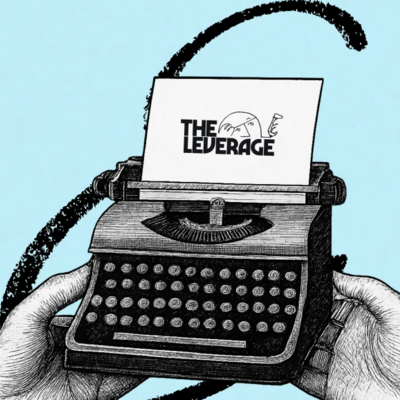
Was this newsletter forwarded to you? Sign up to get it in your inbox.
To truly understand business strategy, you have to accept that it is, by nature, bullshit. Of course, the practice of guiding a business, making choices with trade-offs, and responding to unexpected crises is real. But the academic study of business strategy is something closer to divination.
You may have heard of such famous frameworks as disruptive innovation, blue ocean, or Porter’s five forces. They look smart, sound smart, and are frequently cited by writers like myself. They try to add structure to something innately chaotic and mysterious.
So, why are they bullshit? Simple. The value of a forecasting method is in its ability to be right, not sound right. Despite decades of study and the relentless efforts of the good people over at the Harvard Business School, we have yet to discover any strategy that is universally predictive.
This does not mean that the study of business strategy has no value. Counterintuitively, because no single theory is wholly predictive, you can bundle multiple theories together to generate differentiated insights. Strategy is not business physics—it's analytic art.
When the world gets confusing—say, for example, AI is remaking the entire technology landscape—these frameworks can inform the choices you need to make. The better you know these theories, the more instinctual their lessons become, the more prepared your intellect is, the faster you’ll be able to react to new opportunities in front of you. And when change is happening fast (like it is right now), speed is one of the biggest advantages.
Can you answer the big questions about what AI means for computers and the internet in general? With the proper study of business strategy, you should be able to make a pretty good guess.
Today I’d like to explain what I consider one of the very first pieces of business strategy writing, from 1936. Despite being 88 years old, it can help us answer some of those questions about the nature of companies, what they chose to outsource, and how they interact with each other.
The foundation of business strategy
Our current AI conundrum would not have been a surprise to British economist Ronald Coase. At age 26, he published his legendary essay, "The Nature of the Firm." Coase grapples with a fundamental problem: If the market is efficient, shouldn’t it be cheaper for a firm to outsource the majority of its internal activities to specialized contractors? Markets typically reward specialized labor that can focus on performing one task better than anyone else. At its most elemental, Coase is trying to understand the relative merits of integration (i.e., a company makes all the stuff that goes into its products, like Tesla making many of the components of its cars) versus modularization (a company that uses off-the-shelf components like IBM).
Coase's major insight on this topic was to focus on transaction costs, which are the costs associated with using the market for production and exchange.
In a market, transactions occur through contracts between independent agents, each of which incurs costs. Within a firm, however, transactions are managed internally by a founder or manager, reducing the need for individual contracts for each transaction. Coase argues that firms exist because they can reduce these transaction costs relative to what they would outside the firm.
The size and scope of a firm are determined by the balance between the costs of organizing an extra transaction within the firm and the costs of conducting the same transaction on the open market. A firm will expand until the cost of organizing an additional transaction within the firm equals the cost of carrying out the same transaction through the market.
This theory has several implications: Firms may integrate vertically to reduce transaction costs, or they may outsource functions if the market can perform them more efficiently. The size of a firm is influenced not just by economies of scale but also by the efficiency in managing transaction costs internally instead of through the market.
However, the most important implication is that technology dramatically reduces costs. Widely distributed technology has a way of standardizing the way that firms interact with each other. Let me show you what I mean.
Standardized shipping
On April 26, 1958, 58 boxes left Newark, New Jersey, headed for Houston, Texas, on a converted oil tanker. The tanker was loaded up with shipping containers, a seemingly innocuous occasion.
Source: Maersk.At the time, no one would have predicted that these simple steel containers would be one of the primary drivers of globalization. By transforming shipping from being entirely customized with non-standard containers to the adoption of modular, universal components that every shipper could interact with, the shipping container dramatically reduced costs worldwide. A shipping container could easily move from manufacturer to railroad to boat, all with the same machinery. The impact was enormous. At the time, ocean freight was 12 percent of the average cost of goods. Today, it is an almost relatively negligible component, all due to the strength of the modular box shipping infrastructure.
A new technology with a universal interface that allows for standardized interaction transforms a customized, vertically integrated industry into one of modular components. Shipping companies still competed on cost, but the axis of competition came not from shipping containers but from companies’ ability to reduce labor costs via automation and other forms of competitive advantage.
The platforms
Many internet startups of the last decade—particularly platforms—have similarly focused on reducing transaction costs through technology. They have done so in three ways:
First, they dramatically cut down on search and information costs. Users can easily find and compare services, prices, and reviews, which simplifies the decision-making process. For example, Uber connects riders with drivers in real time, eliminating the need for users to search for transportation options manually.
Second, internet companies reduce bargaining costs by standardizing transactions. Uber and Airbnb provide clear pricing structures and streamlined booking processes, minimizing the need for lengthy negotiations. This standardization makes transactions smoother and faster for both parties. Taskrabbit connects users with freelance workers who can perform various tasks, such as cleaning, moving, or repair services, without the hassle of negotiating prices and terms for each job. The platform sets standardized pricing guidelines and processes so users can quickly find a service provider at a desired rate—reducing the time and effort spent on bargaining, and making transactions more efficient and convenient.
Third, platforms lower policing and enforcement costs. They often have built-in mechanisms for trust and safety, such as rating systems, background checks, and secure payment methods. This ensures that transactions are reliable and reduces the need for users to enforce contracts themselves. Etsy provides mechanisms to build trust and ensure the quality of transactions of the handmade and vintage goods in its marketplace. Sellers on Etsy have profiles with reviews and ratings from previous buyers, helping new buyers make informed decisions. Etsy also offers secure payment options and has policies to handle disputes and ensure buyer protection. These features reduce the need for buyers and sellers to enforce contracts independently, lowering the overall policing and enforcement costs and creating a trustworthy environment for transactions.
Platforms serving intermediaries that handle numerous transactions internally resembles Coase's description of firms reducing transaction costs by internalizing operations. However, companies can go a step further by enabling peer-to-peer interactions, where individuals can transact directly under the platform's oversight and the platform takes a portion of the transactions’ revenue (such as on eBay or StockX).
AI’s impact on transaction costs
You’ll note that I mostly discussed firms in the context of consumer transactions. In the 2010s, numerous software companies that built SaaS applications that could automate workflows emerged. This was good because, ya know, money. But the reason behind the sector’s profitability was that software could automate ever more niche tasks. We went from a customer relationship manager (CRM) for everyone (aka Salesforce) to a CRM specialized for every type of business imaginable, like restaurants or life science companies.
This specialization did, however, have the unfortunate side effect of making it challenging to jump from application to application, workflow to workflow. Your data would either be stored across multiple software applications, databases, and chat apps, or it would be lost entirely as you automated processes away. You can see how this might be problematic.
AI can understand that customization. Remember: Technology used to standardize interfaces (like platform companies or the shipping container) can dramatically reduce costs. By standardizing transactions, AI can act as the meta-layer, smoothly connecting firms' various applications and workflows.
Let that simmer for a second. What I am proposing is that any task that feels tedious, that is dragging and dropping, that doesn’t require your full attention, can be automated away. One study found that workers were only productive for about three hours a day. With AI-powered software, those three hours of real work are all you have to do—the rest is automated away.
AI is able to reduce search and information costs in three ways:
1.) Understanding code: AI can analyze and understand code by reading developer documentation. By leveraging APIs, AI systems can facilitate seamless communication between applications so you don’t have to build these connections on your own. How often do you think, “Ugh, I have to repeat the work I did in one app in another”? When I finish writing this piece in my word processor, I’ll have to copy and format it into our content management system, or CMS (the thing that sends it into your inbox). There is nothing differentiated in that! If both of these tools had an available API, AI could write the connection for me—and my piece would be automatically inputted into our CMS.
2.) Navigating UI: If a company doesn’t provide API access that an AI can plug into, an AI can navigate user interfaces and perform tasks autonomously by mimicking user actions in the browser. The latest AI models are all multi-modal—they can process images as well as text. With their ability to interpret images, they can follow what a user does and then automate it. Microsoft’s initial product for this function is Recall, in which the AI can remember everything you have done on your browser. The natural next step would be a product called “Repeat,” where the AI agent can do the tasks it sees you repeatedly do for you.
Both of these examples are in existence today! Numerous startups are exploring variations of this functionality.
The final example isn’t quite there, but we're getting close.
3.) Understanding semantics: AI can comprehend the meaning and context of data across different applications. Rather than just explicitly mimicking browser workflows or relying on API access, AI could reduce transaction costs because it understands the intentions of what you are trying to do. In other words, it could be proactive in automating tasks and solving problems for you before you set out to do those tasks yourself or realize those problems exist.
When people talk about how AI will change the nature of work, they often focus on the “one-person billion-dollar company” (an idea that won’t work, by the way) or making individuals far more productive. While there is merit to both of these ways of thinking, I find Coase’s paper informative when it comes to AI because it forces your thinking to move one layer above individual productivity. Throughout history, technology's magic has been in reducing transaction costs. Until now, this cost reduction has come from forcing mass adoption of a technological standard, like shipping containers. AI is the first universally flexible technology. It can interact with our digital environments in similar ways to humans, so it can have all the flexibility that we do. In that way, it may be the last technology we ever need.
Evan Armstrong is the lead writer for Every, where he writes the Napkin Math column. You can follow him on X at @itsurboyevan and on LinkedIn, and Every on X at @every and on LinkedIn.
The Only Subscription
You Need to
Stay at the
Edge of AI
The essential toolkit for those shaping the future
"This might be the best value you
can get from an AI subscription."
- Jay S.
Join 100,000+ leaders, builders, and innovators

Email address
Already have an account? Sign in
What is included in a subscription?
Daily insights from AI pioneers + early access to powerful AI tools










Comments
Don't have an account? Sign up!